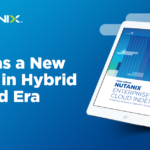Study Shows Hybrid Cloud Steps Up to Meet Business Needs Amidst COVID-19


Pandemic Highlights the Strategic Importance of IT Globally
Nutanix (NASDAQ: NTNX), a leader in hybrid cloud computing, today announced the findings of its third global Enterprise Cloud Index survey and research report, which measures enterprise progress with adopting private, hybrid and public clouds. This year, survey respondents were also asked about the impact of the COVID-19 pandemic on current and future IT decisions and strategy. A key finding: hybrid cloud is still the frontrunner as the ideal IT infrastructure model (86% of respondents think so), and respondents running hybrid environments are more likely to plan to focus on strategic efforts and driving positive business impact.
The pandemic has shifted IT’s focus toward remote worker support and enabling near-instant infrastructure deployments that reach geographically distributed workforces, spurring increased enterprise progress with cloud expansion. Additionally, a greater number of respondents running hybrid environments said they were likely to offer more flexible work setups, strengthen their business continuity plans, simplify operations, and increase digital conferencing usage because of the pandemic.
The majority of respondents (nearly 76%) reported the pandemic made them think more strategically about IT, and nearly half (46%) said their investments in hybrid cloud have increased as a direct result of the pandemic, including public and private clouds. Additionally, businesses also increasingly rely on multiple public clouds to meet their needs compared to previous years. The report showed that, among those who use public clouds, 63% of respondents use two or more public clouds, or multicloud, respondents are also expecting this number to jump to 71% in the next 12 months.
Other key findings of this year’s report include:
• Enterprises have taken key steps toward reaching their IT operating model of choice: Global respondents report taking the initial key steps to successfully run a hybrid environment, including adopting hyperconverged infrastructure in their datacenters and decommissioning non-cloud-enabled datacenters in favor of private and public cloud usage. Global IT teams are also planning for substantial infrastructure changes; they foresee, on average, hybrid cloud deployments increasing by more than 37 percentage points over the next five years, with a corresponding 15-point drop in non-cloud-enabled datacenters. Most notably of the many infrastructure categories, respondents reported running a mixed model of private cloud, public cloud, and traditional datacenter more often than any other (nearly 26%) which is likely a precursor to a hybrid cloud deployment.
• Remote work is here to stay — and companies are planning for it: In last year’s survey, about 27% of respondent companies had no full-time at-home workers. That number fell 20 percentage points this year to only 7%, as a result of to COVID-19. By 2022, respondents predict that an average of 13% of companies will have no full-time remote employees at that time, less than half as many as a year ago in 2019, before COVID struck. Improving IT infrastructure (50%) and work-from-home capabilities (47%) have therefore become priorities for the next 12 to 18 months.
• Strategic business outcomes, not economics, drive change today: Respondents said their primary motives for modifying their IT infrastructures are to get greater control of their IT resources (58%), gain the flexibility to meet dynamic business requirements (55%), and improve support for customers and remote workers (46%). By contrast, just 27% mentioned cutting costs as a driver.
• Educators face unique COVID-19-related challenges and needs: More education-industry respondents cited “ensuring that remote workers have adequate hardware” as a primary challenge than any other issue. 47% also cited providing “adequate communications channels among employees, customers, and clients” as a top challenge. The education sector is taking the right steps toward transformation, ranking high in private cloud deployments, with 29% of respondents saying they were running private clouds only (substantially more than the 22% global average).
“In January, for many companies technology was considered a basic function of a business, enabling core organizational processes,” said Wendy M. Pfeiffer, Chief Information Officer of Nutanix. “Today, technology has taken on an entirely new meaning. It is a complex strategy and it makes or breaks a company’s long-term viability. COVID-19 has accelerated us into a new era of strategic IT and raised its profile considerably, and the findings from this year’s Enterprise Cloud Index reflect this new reality. Hybrid cloud is the frontrunner, and it will continue to be as we navigate our mixing of physical and virtual environments and move away from doing business in a single mode.”
For the third consecutive year, Vanson Bourne conducted research on behalf of Nutanix, surveying 3,400 IT decision-makers around the world about where they’re running their business applications today, where they plan to run them in the future, what their cloud challenges are, and how their cloud initiatives stack up against other IT projects and priorities. The respondent base spanned multiple industries, business sizes, and the following geographies: the Americas; Europe, the Middle East, and Africa; and the Asia-Pacific and Japan region.
To learn more about the report and findings, please download the full third Nutanix Enterprise Cloud Index, here.